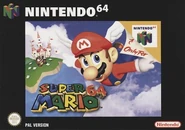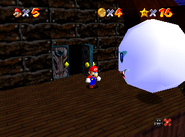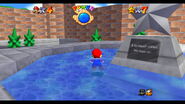Template:Game infobox Super Mario 64 (スーパーマリオ64, Sūpāmario 64) abbreviated as SM64, is the first three-dimensional platformer starring Mario, and was released on the Nintendo 64 in 1997 in Europe and 1996 elsewhere. At the time, it received widespread critical acclaim, and has been often said to have defined its genre by being one of the first well-made games of its type. The game has since been remade on the Nintendo DS in the form of Super Mario 64 DS. There was going to be a sequel made, called Super Mario 64 2, but was cancelled.
Story
Princess Toadstool sends Mario to come to her castle to have a cake. When Mario arrives, he meets the Lakitu Bros., whom are filming Mario. They go inside the castle and hear a familiar voice telling him to get out of the castle. Toad informs him that Bowser has kidnapped the princess again and is holding everyone hostage inside the castle walls. He has also stolen the Power Stars and given them to his minions who are hiding in paintings spread all over the castle. Mario hops in the magical paintings and retrieves the Power Stars in order to defeat Bowser and save the Princess.
During the journey, Mario makes his way to more areas of the castle. When he finds out he has enough stars, he goes into Bowser's final level. Once he makes his way through the long course, Mario sees Bowser, and the two battle. When Mario defeats Bowser, he gives up and hands him a Giant Power Star, before he explodes. Mario grabs the star, and has been given the Wing Cap and flies away back to the castle.
As Mario's Wing Cap disappears, he uses the Giant Power Star to make Princess Peach appear. Peach wakes up and thanks Mario, by giving him a kiss, and the cake she had promised before.
Characters
Playable
Allies
Enemies
- Amps
- Bill Blasters
- Big Steelies
- Bob-ombs
- Boos
- Bookends
- Bubs
- Bubbas
- Bullet Bills
- Bullies
- Chain Chomps
- Chuckyas
- Fire Guys
- Fire Spitters
- Fwooshes
- Goombas
- Grand Goombas
- Grindels
- Heave Hos
- Killer Chairs
- Kleptos
- Koopa Troopas
- Kuromames
- Lakitus
- Mad Piano
- Micro-Goombas
- Moneybags
- Monty Moles
- Mr. Blizzards
- Mr. Is
- Piranha Plants
- Podoboos
- Pokeys
- Pushy Walls
- Scuttlebugs
- Skeeters
- Snufits
- Spindels
- Spindrifts
- Spinies
- Sushis
- Swoopers
- Thwomps
- Tox Boxes
- Tweesters
- Ukikis
- Unagis
- Venus Fly Traps
- Whomps
Bosses
Gameplay
The aim of the game is to collect enough Power Stars to progress to new, previously inaccessible areas of the castle. The primary goal is to collect enough to reach the final battle and save Princess Peach from Bowser. Each level, or "course", holds six stars, plus one for collecting one hundred coins, which are obtained by completing a certain mission. The only clue to what this may be is in the star's title, which is often cryptic. Aspects of each course vary with each star; beyond this, the player is given free reign in exploring each world.
Super Mario 64 introduced a number of abilities to the series, allowing Mario to crawl, Ground Pound, punch and kick, backflip, sideflip, wall-kick, long-jump and slide, amongst others. These moves give the player a greater freedom than in past games as regards ways that Mario can be controlled, introducing the idea of there being a number of alternative routes to arrive at any one place. These are additionally used to perform actions such as pressing down switches as well as harming enemies or reaching high or distant places. The game's use of the Nintendo 64 controller's Analog stick is another first for the Mario series, and allows the player to move Mario at different speeds by controlling the stick. This allows Mario to walk slowly, which, as opposed to running, does not awaken sleeping enemies.
Caps are another aspect introduced to the gameplay in Super Mario 64, giving Mario the ability to fly, walk underwater or walk through certain barriers. They are turned on in short bursts, and made available when activated with the switch associated with each one.
Levels
Levels in the game are accessed by jumping into holes or portraits, usually the latter, and each consists of a differently-themed world existing outside the castle. All but Bob-omb Battlefield, the first one, are inaccessible from the start of the game. In order to get to the different rooms which contain the paintings that Mario needs to enter to get to another level, stars must be collected from the levels already unlocked, and keys obtained from boss battles with Bowser.
As well as the fifteen main courses, there are a number of secret areas, containing one or two stars, and possibly other unlockable items or boss battles. The stars obtained from these constitute the remaining fifteen stars, called "Castle Secret Stars".
Courses
- Bob-omb Battlefield is the first world, or level, that Mario is able to enter. This course is basic with Goombas and Bob-ombs, and the Big Bob-omb is the boss here.
- Whomp's Fortress is the second level of the game. Once Mario has collected at least one star from the previous level, he is able to enter Whomp's Fortress. The course contains several Whomps and Piranha Plants, and the Whomp King is fought here.
- Jolly Roger Bay - The third level of the game. The course involves swimming, and has a large boat present. Eels are found here.
- Cool, Cool Mountain - The fourth level. A snowy mountain that Mario can slide down. Some penguins are here and a body-less snowman.
- Big Boo's Haunt - The fifth level. A ghost house filled with Boos and spinning eyeballs.
- Hazy Maze Cave is the sixth level. A large underground area, with a toxic maze, a lake and rolling boulders.
- Lethal Lava Land - A level with a volcano, lava and moving platforms. Bullies are found here.
- Shifting Sand Land - A desert land with a pyramid, and quicksand. Many Pokeys, Propeller Shy Guys, and Tox Boxes are here.
- Dire Dire Docks - An area you have to get the first star from before accessing Bowser in the Fire Sea. A giant dock is here, as well as a submarine.
- Snowman's Land - A large snowman in the middle of a large plain of snow, surrounded by several ice lakes and an ice sculpture.
- Wet-Dry World - An area where you can step on switches to raise or lower the water level to access new areas.
- Tall, Tall Mountain A very tall mountain that Mario has to scale to find stars and secrets.
- Tiny-Huge Island An island where Mario is either small or huge, and can change the size using Warp Pipes.
- Tick Tock Clock A large clock which Mario must climb up to find stars, utilizing things that move at certain times.
- Rainbow Ride - The final main course. Mario must use magic carpets to navigate. An Airship and a large house are found here.
Secret Courses
- The Princess's Secret Slide - A large slide filled with 1-Ups and coins.
- The Secret Aquarium - A giant fish-tank filled with eight Red Coins.
- Wing Mario Over the Rainbow - A stage in the sky where Mario must fly around using cannons to collect eight Red Coins.
Cap Switch Courses
The game's three caps must be activated before the blocks that allow Mario to use them are made solid. This is done by pressing the switch for each, found in the cap's respective course.
- Tower of the Wing Cap is reachable after ten stars have been collected. Mario is given the Wing Cap and must fly around the area surrounded by four towers to collect the eight Red Coins.
- Vanish Cap Under the Moat is located under the moat of the castle, reachable after the moat of water has been drained. Mario is given the Vanish Cap and must make his way down a slide, before using see-saws to try and get eight Red Coins.
- Cavern of the Metal Cap is located in the Hazy Maze Cave. Mario is given the Metal Cap and can go through strong currents to try and get eight Red Coins.
Bowser levels
Bowser levels are obstacle courses that lead up to an encounter with Bowser, comprising the game's three major boss battles.
- Bowser in the Dark World - the first encounter with Bowser. Mario navigates through fire-spitting statues, moving platforms and takes a fall down to the platform where Bowser awaits. Grab his tail, make a spin and toss him towards one of the bombs attached to the rim of the stage. One hit is enough, and Mario will now be able to get to the lowest basement of the castle.
- Bowser in the Fire Sea - the second encounter with the evil Koopa King. This one is situated in a giant arena of fire, constituted of Goombas, fire-breathing blocks, and sinking platforms. After a short pole maze, Mario can fight Bowser, who can now jump and turn the fighting stage on end. One swing into a bomb kills him, and Mario can then access the second floor of the castle.
- Bowser in the Sky - the third and final encounter with Bowser. This one is a longer course, involving more fire, Goombas, wind, Piranha Plants, and even the odd Whomp. It takes three hits to kill him, including one on a very small platform, before Bowser gives up Princess Peach.

Wing Cap
Power-ups
- Wing Cap - this cap enables Mario to fly by performing a triple jump, or blasting out of a cannon.
- Vanish Cap - this cap transforms Mario into Vanish Mario which makes him invulnerable to attacks. He can also walk through some walls, and gates.
- Metal Cap - this cap grants Mario partial invincibility which makes him walk into enemies, as well as avoid fire, water currents, and allows him to walk underwater.
Items
- Power Star - The main source of power in this game. Mario must collect 121 in total to fully complete the game (although not necessary; the final stage only requires 70, and the 'End Game' interaction with Yoshi can be achieved without the 121st or 122nd stars). These stars unlock certain areas and events, along with certain doors that require keys to be opened.
- Coin - They are the most basic objects in the game. These items refill Mario's health, and if Mario collects 100 of them in a single level, he earns a Power Star.
- Red Coin - Eight of these special coins appear in each course. They are worth two coins each. Collecting eight of these total earns Mario a Power Star.
- Blue Coin - These items first appear in Whomp's Fortress, and are worth five golden coins each. They are also dropped by more uncommon enemies, including Ground Pounding the Giant Goombas on Tiny-Huge Island.
- Green Shell - These items help Mario cross water and lava whilst riding, and can also be used to jump certain gaps. They can also be found on Koopa Troopas, hence they are sometimes referred to as Koopa Shells.
- Exclamation Block - These items release the Metal Cap, Vanish Cap, or the Wing Cap when hit, coming from green, blue, and red blocks, respectively. These blocks require that Mario presses the required button, otherwise they are transparent and will not give any caps.
- 1-Up Mushroom - These mushrooms give Mario an extra life when collected.
- Wing Cap - This cap allows Mario to fly.
- Vanish Cap - This cap allows Mario to walk through walls and become invisible.
- Metal Cap - This cap allows Mario to turn into metal and, due to his weight, walk underwater.
Regional Differences
There are some regional differences between the U.S, Japan,PAL, and the Shindou releases of Super Mario 64.
List of Differences between U.S, and Japanese Versions:
- In the U.S version when you start the game, Mario says "Hello!" to the player on the screen. The Japanese version does not have this.
- In the U.S version when you select a file in the file select screen, Mario says something to the player. In the Japanese release, it does not have this.
- Mario says "let's-a-go" when you select a star in the course selection in the U.S version.
- When the letter from Princess Peach is shown in the intro, Peach speaks on what she wrote. Again the Japanese version doesn't have the voice acting.
- In the Game Over screen when Mario appears, he says "Game-over!". This once again is not said in the Japanese release.
- The Chain-Chomp sounds a lot different in the Japanese version than the U.S version.
- The red coins' sound has a higher pitch when you collect it in the U.S release. The Japanese release has a high-pitched coin sound but it remains when you collect more red coins.
- In the Japanese version, in the Jolly Roger bay level one star can be collected by jumping off the needle and then grabbing it. But in the U.S version, you have to open a box in order to get it.
- In one mission for Cool, Cool Mountain you have to bring the penguin back to its mom. But for some reason, the star is placed in a different position.
- After collecting a key in one Bowser mission, the key floats above Mario's head when you get it. The Japanese version doesn't have this.
- In the JP version, there was an error in the code, if Mario gets 1,000 coins, Mario's lives is -25, if Mario dies, Mario's lives is -25, spite the counter does not reset when returning to the castle, if Mario enters a level, it resets to 0. However, if Mario gets 32,768 coins, it is no longer true that coins>999, so the game is no longer constantly setting Mario's lives to -25. However, if Mario dies when the counter is 0, Mario's lives go from -25 to -26, if it was -128, it will go down from -128 to 100, not 127.
- Error shown in red. V
- GCode: if (lives>100) then lives=100; if (coins>999) then lives=999
- ICode: if (lives>100) then lives=100; if (coins>999) then coins=999
PAL Version Differences:
- In the PAL version the game runs at only 25 frames per second while the U.S and Japanese have 30 frames per second.
- In the PAL version, for some reason, when you enter a Bowser door, the sound is different.
- The painting for the Jolly-Roger bay course is different in the U.S and PAL version as it shows a ship rather than bubbles which are shown in the Japanese version of the game.
Shindou Version Release:
- When you release Bowser after spinning him, Mario only says "Bye-Bye!" rather than "So long King Bowser!" or "Here we go!". This is because Bowser's Japanese name is ''Koopa''.
- When you grab on a tree and release out of it, you actually spin a lot longer than in any other version of the game.
Gallery
Ratings
- GameRankings gave the game a high score of 95.9%/100%.
Trivia
- Contrary to popular belief, this game was technically NOT Charles Martinet's debut as Mario's voice actor - this instead happened in Mario's FUNdamentals. However, it is the first mainstream Mario game he voiced, and thus, is regarded as his effective debut in the role.
- Though false, the Gamers edition of the Guinness Book of World Records 2011 states that Super Mario Bros. was ported to the Nintendo 64, vaguely referencing Super Mario 64 being one of its sequels.
- This is the first Mario game to feature a method of invincibility other than a Starman.
- Although the Starman's music was retained for certain bonus stages, as well as when Mario possesses the Wing and Vanish Caps, or surfs on a Koopa Shell.
- This was the very first Mario game to not include Mushrooms or Fire Flowers.
- Wrinkly can sometimes be seen playing Super Mario 64 in her Save Cave in the Super Nintendo Entertainment System version of Donkey Kong Country 3: Dixie Kong's Double Trouble!, due to the "Behind the Castle Walls" music explaining it all.
- Super Mario 128 was supposed to be its sequel, but it got some tweaks and is now Pikmin, which technically makes Pikmin Super Mario 64's "sequel".
- Pressing the A button on the "Press Start" screen that has Mario's face on it will cause a hand to appear, allowing the player to stretch Mario's ears, nose, cheeks, mouth, and the top of his head.
- Holding the R button will lock Mario's face in the stretched position.
- Boo's laugh is a high-pitched version of Bowser's laugh, most likely to save space.
- Tiny-Huge Island is a reference to Super Mario Bros. 3.
- The song titled Bowser's Road from this game was remixed at certain parts in Super Smash Bros. Melee. This was later remixed for Super Mario Galaxy.
- This is one of the two 3D Mario games to not feature Luigi, the second being is Super Mario Sunshine.
- Luigi was rumored to appear in the game. It was said you have to run around the fountain 2401 times to unlock him. This is very similar to when Waluigi was rumored to appear in the DS version.
- Luigi was initially discussed for the game during the development period, but never went beyond discussion as the game was already proving to be quite a test on the N64's hardware just with Mario alone.










